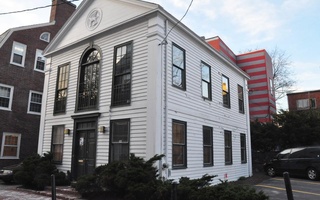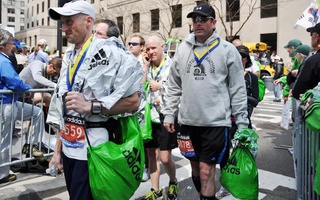Robots playing soccer, medical device prototypes, and visualization demos were among dozens of projects on display at the School of Engineering and Applied Sciences Design Fair on Tuesday.
The fair, in its inaugural year, took place in Maxwell Dworkin, showcasing student creativity through project posters, exhibitions, and interactive demonstrations.
More than ten SEAS undergraduate design courses were represented, with projects focusing in applied mathematics, the engineering sciences, and computer science.
Mechanical and Biomedical Engineering assistant professor Conor J. Walsh said that the fair was a great opportunity for students to show off their work and raise awareness of the exciting opportunities that are available within SEAS.
“The faculty and staff in SEAS are really excited about incorporating more hands-on design projects into the various classes,” Walsh said, “I think that it will get students really excited about design and help create engineers that can work on real-world problems even before they graduate.”
Students drew upon lessons learned in a variety of classes to implement their projects, many of which spanned across disciplines.
“My project drew from many different classes I have taken throughout my time at Harvard,” said Jennifer A. Xia ’12, who showcased her thesis, an investigation into the factors that go into Facebook friendship creation at Harvard.
“Certainly a little bit of computer science for the programming aspect, a little bit of applied math for the modeling part, a little statistics and sociology,” Xia said.
The projects also allowed students such as Michaela S. Tracy ’13 to explore their personal interests from unconventional perspectives.
Tracy, a singer and composer, explored her love of music by modeling the movement of musical chords and recreating different melodies in Applied Mathematics 120: ”Applicable Linear Algebra.”
Though the fair focused on projects within SEAS courses, the participating students represented a variety of academic backgrounds outside the department.
Kayla M. Shelton ’13, an engineering sciences concentrator who built an LED cube with philosophy concentrator Aruna Gnanasekaran ’12, said that she benefited greatly from the diversityof students within Engineering Sciences 50: “Introduction to Electrical Engineering.”
“It’s incredible to meet and work with interesting people pursuing concentrations outside of the sciences,” Shelton said. “It really speaks to the importance of having design skill with respect to taking on the world.”
For many students, the fair represented the culmination of months of planning, testing their ideas, debugging, and rebuilding. Mubeen M. Tejani ’14, who built a laser harp for ES50, said that one of the greatest challenges was adapting his project to fit the hardware constraints.
“In computer science, you know your hardware’s going to work. It’s only a matter of software. In engineering, you can’t assume that,” Tejani said. Students echoed his sense of fulfillment gained from their projects.
“The biggest reward was seeing it finally work,” Luis F. Duarte ’13 said of the interactive mobile “Battleships” application that he designed for Computer Science 164: “Mobile Software Engineering.”
“You have this idea in your head and you spend time figuring out how to execute it. But once it’s actually there, you can have fun with it,” Duarte added. “That’s the reward.”
—Staff writer Akua F. Abu can be reached at aabu@college.harvard.edu.
Read more in News
As Crunch Time Hits, Some Students Turn to Dangerous Study DrugRecommended Articles
-
 Advocate Archives Issue
Advocate Archives Issue -
 Students Run in Boston Marathon
Students Run in Boston Marathon -
Morgan Stanley Exec To Serve as HMC's Chief Risk OfficerA Morgan Stanley executive will take over as Harvard Management Company’s next chief risk officer, the body announced Wednesday.
-
Preserve Our Ties and Our IdealsThe University should not act to terminate its broadly positive influence in China
-
'Empty Chairs' Full of FeelingLiu Xia has seen her husband and her brother repeatedly arrested, jailed, and imprisoned, for likely politically-motivated reasons, and has herself been placed under house arrest and constant surveillance. It is no wonder that Kafka is a recurring figure in her poetry.













